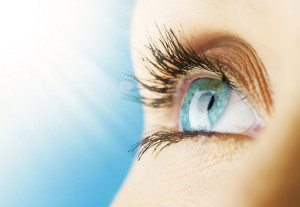Eye Trivia: Five Fascinating Facts About Your Eyes

The human eye is an incredibly complex organ with millions of components working together to provide us with a picture of the world around us. They are known as the “windows to the soul” in many cultures and are often crucial in building connections with others. But there is so much more to these vital organs. So, we’re taking a look at five fascinating eye facts that will leave you in awe of your peepers.
1. 20/20 Vision is not so special after all
When trying to get your point across about how good someone’s vision is, it is likely you would say something along these lines:” Oh, he can see for miles, he has 20/20 vision!”. In fact, this label is almost universally understood to mean that someone has exceptional vision – but this isn’t actually the case.
In fact, 20/20 (or 6/6) vision simply means you have average vision. That is, when standing 20 feet away, you can make out what a person with normal visual acuity would be able to see at that distance. So, next time you want to boast about your exceptional vision, don’t say you have 20/20 – tell them you have 20/16 vision!
2. Blinking ‘eck! That’s a lot of blinks
The human eye is enclosed in upper and lower lids that close when we sleep and blink. However, most of us never even notice when we are blinking – it is simply an instinctual bodily function that helps keep our eyes lubricated and functioning as they should.
On average, we blink 12-20 times per minute, 11,520 times per day, and up to 5.2 million times per year! When put into time, the average person is said to spend around 45 minutes to an hour with their eyes closed every day, thanks to blinking! We tend to blink more often when talking and less often when concentrating on tasks such as reading, which may explain why our eyes become more tired during these periods.
Finally, blinking is the fastest muscle movement we can control, with each blink lasting around a tenth to a third of a second! We can blink up to five times in one second – now that’s blinking fast!
3. There are many more than 50 Shades of Grey!
Okay, so the title of the popular book and film franchise isn’t actually referring to how many shades of grey the human eye can distinguish; however, you might be surprised that this would be quite a conservative estimate if it were. In fact, it is estimated that the human eye can make out up to 500 different shades of grey, although this also depends on the individual’s eye health and viewing circumstances.
But generally, when allowing for a 1% increase in ‘brightness’ between shades, the average person can probably see around 100 different shades.
4. Fatigued by yellow
Our eyes react differently to different colours, and it is claimed that bright yellow is the most tiring to look at. But why is this? Well, more light is reflected by bright colours, and apparently, yellow reflects the most light of them all. Staring at this bright light results in excessive eye stimulation and thus fatigue.
That said, yellow is also considered a cheerful colour in many settings, and it is sure to get attention. Still, if you want to paint your walls yellow, it might be best to opt for a paler or more muted shade that won’t prove to be an irritant for your eyes!
5. The bloodless window to the eye
At the front of our eyes, the pupil and iris are covered with a clear structure known as the cornea. This transparent layer of tissue allows light to pass through the lens and onto the retina at the back of the eye. But something is interesting about the cornea: It is the only tissue in the human body without blood vessels!
The reason for this is simple. If there were blood vessels in the cornea, they would obstruct light and result in a rather odd picture of the world around us… However, in some cases, unhealthy eyes can begin to form blood vessels that grow into the cornea. This is known as corneal neovascularisation – a rare side effect of wearing contact lenses, infection, or injury.
So there you have it! Our eyes are truly remarkable, providing us with vital information about the world we live in. But they don’t always work exactly as they should. If you have a refractive error and are tired of glasses and contact lenses, it might be time to consider Laser Eye Surgery. Get in touch with one of our friendly clinic coordinators or Book a Consultation today!


